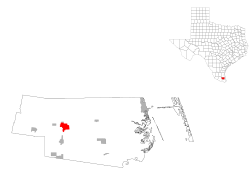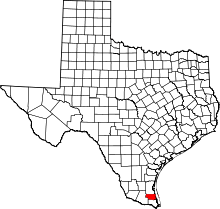Raymondville, Texas
| Raymondville, Texas | |
|---|---|
| City | |
| City of Raymondville | |
|
Location of Raymondville, Texas | |
 | |
| Coordinates: 26°28′53″N 97°46′59″W / 26.48139°N 97.78306°WCoordinates: 26°28′53″N 97°46′59″W / 26.48139°N 97.78306°W | |
| Country | United States |
| State | Texas |
| County | Willacy |
| Area | |
| • Total | 3.8 sq mi (9.8 km2) |
| • Land | 3.8 sq mi (9.8 km2) |
| • Water | 0.0 sq mi (0.0 km2) |
| Elevation | 30 ft (9 m) |
| Population (2000) | |
| • Total | 9,733 |
| • Density | 2,564.4/sq mi (990.1/km2) |
| Time zone | Central (CST) (UTC-6) |
| • Summer (DST) | CDT (UTC-5) |
| ZIP codes | 78580, 78598 |
| Area code(s) | 956 |
| FIPS code | 48-60836[1] |
| GNIS feature ID | 1377181[2] |
Raymondville is a city in and the county seat of Willacy County, Texas, United States.[3] The population was 9,733 at the 2000 census. It may be included as part of the Brownsville–Harlingen–Raymondville and the Matamoros–Brownsville metropolitan areas.
Raymondville was formed in 1904 by Edward Burleson Raymond, a foreman of the El Sauz Ranch portion of the King Ranch and owner of the Las Majadas Ranch.[4]
Geography
Raymondville is located at 26°28′53″N 97°46′59″W / 26.48139°N 97.78306°W (26.481464, -97.783013)[5] and is known as the "Gateway to the Rio Grande Valley." According to the United States Census Bureau, the city has a total area of 3.8 square miles (9.8 km²), all of it land.
Soils are mostly clay or sandy clay loams which are well drained or moderately well drained. Some fine sandy loams underlie the eastern part of town. These have near neutral pH. Other parts of town have moderately alkaline, somewhat saline soils. Around the southern edge of town is an area of strong salinity which imposes limitations on farmers and gardeners.
Climate
The climate in this area is characterized by hot, humid summers and generally mild to cool winters. According to the Köppen Climate Classification system, Raymondville has a humid subtropical climate, abbreviated "Cfa" on climate maps.[6]
Demographics
| Historical population | |||
|---|---|---|---|
| Census | Pop. | %± | |
| 1930 | 2,050 | — | |
| 1940 | 4,050 | 97.6% | |
| 1950 | 9,136 | 125.6% | |
| 1960 | 9,385 | 2.7% | |
| 1970 | 7,987 | −14.9% | |
| 1980 | 9,493 | 18.9% | |
| 1990 | 8,880 | −6.5% | |
| 2000 | 9,733 | 9.6% | |
| 2010 | 11,284 | 15.9% | |
| Est. 2015 | 11,139 | [7] | −1.3% |
As of the census[1] of 2000, there were 9,733 people, 2,514 households, and 2,016 families residing in the city. The population density was 2,564.4 people per square mile (988.9/km²). There were 2,842 housing units at an average density of 748.8 per square mile (288.8/km²). The racial makeup of the city was 69.91% White, 3.91% African American, 0.59% Native American, 0.10% Asian, 23.29% from other races, and 2.20% from two or more races. Hispanic or Latino of any race were 86.63% of the population.
There were 2,514 households out of which 41.0% had children under the age of 18 living with them, 57.6% were married couples living together, 18.8% had a female householder with no husband present, and 19.8% were non-families. 18.4% of all households were made up of individuals and 11.8% had someone living alone who was 65 years of age or older. The average household size was 3.45 and the average family size was 3.97.
In the city the population was spread out with 29.9% under the age of 18, 13.1% from 18 to 24, 27.8% from 25 to 44, 17.5% from 45 to 64, and 11.7% who were 65 years of age or older. The median age was 30 years. For every 100 females there were 117.5 males. For every 100 females age 18 and over, there were 119.5 males.
The median income for a household in the city was $19,729, and the median income for a family was $23,799. Males had a median income of $20,034 versus $14,502 for females. The per capita income for the city was $8,910. About 32.7% of families and 36.2% of the population were below the poverty line, including 45.0% of those under age 18 and 30.7% of those age 65 or over.
In 2010, Raymondville was 77% Catholic, 10.5% Southern Baptist, and 4% United Methodist.[9]
Infrastructure
Raymondville is the location of three private prisons, all adjacent to each other:[10]
- the Willacy County Correctional Center (26°28′12″N 97°45′44″W / 26.469897°N 97.762176°W), owned and operated by the Management and Training Corporation under contract with the U.S. Immigration and Customs Enforcement located on the east side of Interstate 69E/U.S. Route 77.[11] Constructed in 45 days, opened in 2006 and closed in March 2015 after destructive riots, the center was a large "tent city" federal holding center for illegal immigrants.[12]
- the Willacy County Regional Detention Center aka the Willacy Detention Center (26°28′15″N 97°45′32″W / 26.470818°N 97.758837°W) opened in 2003. It's operated by Management and Training Corporation housing federal prisoners for the U.S. Marshal Service.
- the Willacy County State Jail (26°28′01″N 97°46′03″W / 26.467076°N 97.767420°W), operated by the Corrections Corporation of America under contract with the Texas Department of Criminal Justice, is a medium-security facility with a capacity of 1069.[13] CCA has managed this facility since 2004. This facility was opened by Wackenhut, now GEO Group, in 1996. On April 26, 2001 inmate Gregorio De La Rosa, Jr. was beaten to death by other prisoners. This incident caused a $42.5 million civil settlement against Wackenhut.[14]
The United States Postal Service operates the Raymondville Post Office.[15]
The Raymondville Independent School District serves the city.
The Reber Memorial Library is located in Raymondville.[16]
The Raymondville Chronicle and Willacy County News, a weekly newspaper, is published in Raymondville.
Notable people
- Singer Angela Via (1981-) was born and raised in Raymondville.[17]
- Businessman Clinton Manges (1923-2010) lived in Raymondville, married a native belle, built and owned a bowling alley.[18]
Weather disasters
The most memorable natural disaster to occur in Raymondville was 1967's Hurricane Beulah, a category 5 hurricane at peak intensity. Beulah made landfall in southern Texas as a category 3 storm.
Films
Raymondville's history was the subject of the film, Valley of Tears. The movie visits the Mexican-American community that had worked the onion fields of rural south Texas in three different eras, observing how the seeds of change planted 20 years ago seem ready to bear fruit today. Politicians, and officials interviewed in the film include Larry Spence, former District Attorney Juan Angel Guerra, Paul Whitworth, Wetegrove families, Dr. Allan Spence and school board and city council members.[19]
References
- 1 2 "American FactFinder". United States Census Bureau. Retrieved 2008-01-31.
- ↑ "US Board on Geographic Names". United States Geological Survey. 2007-10-25. Retrieved 2008-01-31.
- ↑ "Find a County". National Association of Counties. Retrieved 2011-06-07.
- ↑ Edward Burleson Raymond, Texas Historical Marker
- ↑ "US Gazetteer files: 2010, 2000, and 1990". United States Census Bureau. 2011-02-12. Retrieved 2011-04-23.
- ↑ Climate Summary for Raymondville, Texas
- ↑ "Annual Estimates of the Resident Population for Incorporated Places: April 1, 2010 to July 1, 2015". Retrieved July 2, 2016.
- ↑ "Census of Population and Housing". Census.gov. Retrieved June 4, 2015.
- ↑ "Raymondville, Texas (TX 78580) profile: population, maps, real estate, averages, homes, statistics, relocation, travel, jobs, hospitals, schools, crime, moving, houses, news". City-data.com. Advameg, Inc. Retrieved 2013-09-10.
- ↑ Tyx, Daniel Blue (26 March 2015). "Goodbye to Tent City". Texas Observer. Retrieved 30 July 2016.
- ↑ "Willacy Detention Facility." U.S. Immigration and Customs Enforcement. Retrieved on May 9, 2010.
- ↑ Jodi Goodwin, Amy Goodman, & Juan González (February 23, 2007). Raymondville: Inside the Largest Immigration Prison Camp in the US. Democracy Now!. Retrieved 2013-09-10.
The largest immigrant prison camp is in Raymondville, Texas. Some two thousand undocumented immigrants are currently being held in the prison awaiting deportation.
- ↑ "Willacy County State Jail". Corrections Corporation of America. Retrieved 30 July 2016.
- ↑ "Appeals Court upholds $42.5 million wrongful death suit against Wackenhut". Raymondville Chronicle / Willacy County News. 8 April 2009. Retrieved 30 July 2016.
- ↑ "Post Office Location - RAYMONDVILLE." United States Postal Service. Retrieved on May 9, 2010.
- ↑ "Reber Memorial Library." Raymondville Chamber of Commerce. Retrieved on May 9, 2010.
- ↑ "Most Popular People Born In "Raymondville/ Texas/ USA"". IMDb. Retrieved 2013-09-10.
- ↑ Wilcox, Robert (September 29, 2010) [2006]. "Millionaire Texas Oil Man, Clinton Manges, began his career in Raymondville". Raymondville Chronicle and Willacy County News. Raymondville, Texas.
- ↑ Tanzer, Joshua. "film review VALLEY OF TEARS documentary movie about Mexican-American farm workers in rural Texas". Offoffoff.com. Retrieved 2013-09-10.
"Valley of Tears" is a look into another world. The little town of Raymondville, Texas, ...near the Rio Grande — which jokingly calls itself "The Breath of a Nation" — is a little piece of America at its most troubling.
